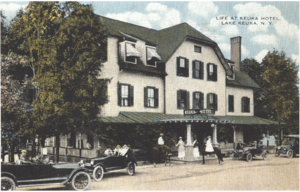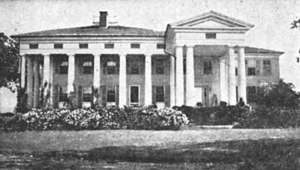Wayne, New York facts for kids
Quick facts for kids
Wayne, New York
|
|
|---|---|
| Country | United States |
| State | New York |
| County | Steuben |
| Named for | Anthony Wayne |
| Area | |
| • Total | 22.60 sq mi (58.52 km2) |
| • Land | 20.58 sq mi (53.31 km2) |
| • Water | 2.01 sq mi (5.22 km2) |
| Elevation | 1,345 ft (410 m) |
| Population
(2020)
|
|
| • Total | 1,006 |
| • Estimate
(2021)
|
997 |
| • Density | 49.27/sq mi (19.02/km2) |
| Time zone | UTC-5 (Eastern (EST)) |
| • Summer (DST) | UTC-4 (EDT) |
| FIPS code | 36-78883 |
| GNIS feature ID | 0979612 |
Wayne is a small town in the northeast part of Steuben County, New York, United States. In 2020, about 1,006 people lived there. The town was named after a famous general from the Revolutionary War, Anthony Wayne.
The Town of Wayne is located northeast of the town of Bath.
Contents
History of Wayne
The area where Wayne is now was first settled by Europeans around 1791. One of the first settlers was Abraham Hendricks. The town was officially created on May 18, 1796. It was first called "Frederickstown." This happened when Steuben County was formed from a larger area called Ontario County. Some other early settlers included Ephriam Sanford, Anthony Swarthout, Jabez Hopkins, and Joseph Bailey.
The town's name was changed to "Wayne" on April 6, 1808. This was done to honor General Anthony Wayne, a hero of the Revolutionary War. At first, the town of Wayne was much larger. Over time, parts of it were used to create other towns. These new towns included Reading (in 1806), Orange (in 1813), and Barrington and Tyrone (in 1822). In 1854, the town became even smaller when some land was given to the town of Tyrone. There was also a place called "Wayne Four Corners" further south in the township.
Famous People and Places in Wayne
A person from Wayne named Jonathan Goble is believed to have invented the rickshaw in 1859. He was a Marine who traveled with Commodore Matthew Perry. Perry's group helped open Japan to trade with Western countries. Jonathan Goble later returned to Japan as a missionary. He was inspired to create the rickshaw to help his wife, who was sick, get around the streets of Tokyo.
Francis M. McDowell was also born in Wayne, New York. He was one of the seven people who started the National Grange. This is a group that supports farmers. He was also its treasurer for 21 years. In the 1860s, he came back to Wayne to grow grapes near Lake Keuka. He also worked with his brother-in-law, Samuel Hallett, on different projects. Samuel Hallett built the biggest house in Wayne. It was called the "Aisle of Pines." This large mansion had 20 columns and was built in 1854. Sadly, it burned down in 1974.
A well-known building in the town was the Keuka Hotel. It was built in 1895 right on the shore of Lake Keuka. A famous musician named Hoagy Carmichael played the piano and sang at the hotel for two seasons. People in the area say that he wrote his famous 1927 song, "Stardust", while he was staying at the Keuka Hotel.
Geography of Wayne
The town of Wayne covers a total area of about 22.6 square miles (58.5 square kilometers). Most of this area, about 20.7 square miles (53.3 square kilometers), is land. The rest, about 1.9 square miles (5.2 square kilometers), is water.
The northern border of the town, and part of its eastern border, is shared with Yates County. The rest of the eastern border is shared with Schuyler County. The northern part of Wayne is located on the southeastern shore of Keuka Lake. Also, a part of the eastern section of the town is on the west shore of Waneta Lake.
New York State Route 54 is a road that runs along the eastern shore of Keuka Lake. Another road, New York State Route 230, goes through the northeastern part of the town.
Population and People
| Historical population | |||
|---|---|---|---|
| Census | Pop. | %± | |
| 1820 | 3,607 | — | |
| 1830 | 1,172 | −67.5% | |
| 1840 | 1,377 | 17.5% | |
| 1850 | 1,347 | −2.2% | |
| 1860 | 944 | −29.9% | |
| 1870 | 891 | −5.6% | |
| 1880 | 827 | −7.2% | |
| 1890 | 889 | 7.5% | |
| 1900 | 838 | −5.7% | |
| 1910 | 643 | −23.3% | |
| 1920 | 516 | −19.8% | |
| 1930 | 516 | 0.0% | |
| 1940 | 577 | 11.8% | |
| 1950 | 581 | 0.7% | |
| 1960 | 715 | 23.1% | |
| 1970 | 902 | 26.2% | |
| 1980 | 1,066 | 18.2% | |
| 1990 | 1,029 | −3.5% | |
| 2000 | 1,165 | 13.2% | |
| 2010 | 1,041 | −10.6% | |
| 2020 | 1,006 | −3.4% | |
| 2021 (est.) | 997 | −4.2% | |
| U.S. Decennial Census | |||
In 2000, there were 1,165 people living in Wayne. There were 494 households, and 363 of these were families. The population density was about 56 people per square mile (19 people per square kilometer).
About 23% of the households had children under 18 living with them. Most households, about 65%, were married couples living together. The average household had 2.36 people, and the average family had 2.75 people.
The median age of people in the town was 47 years old. This means half the people were younger than 47 and half were older.
Communities and Locations in Wayne
- Grove Springs – This is a small village, called a hamlet, located on the shore of Keuka Lake. It is south of Keuka on NY-54.
- Keuka – This hamlet is also on the shore of Keuka Lake, where NY-54 and NY-230 meet.
- North Urbana – This hamlet is found on the western border of the town.
- Sylvan Beach – This hamlet is southwest of the main Wayne hamlet. It is on County Road 97, on the west side of Waneta Lake.
- Wayne – This is the main hamlet of Wayne. It is on the eastern border of the town, so part of it is actually in Schuyler County. NY-230 goes through this hamlet.
- Wayne Four Corners – This is a specific spot in the southern part of the town, located east of North Urbana.
See also
 In Spanish: Wayne (Nueva York) para niños
In Spanish: Wayne (Nueva York) para niños




